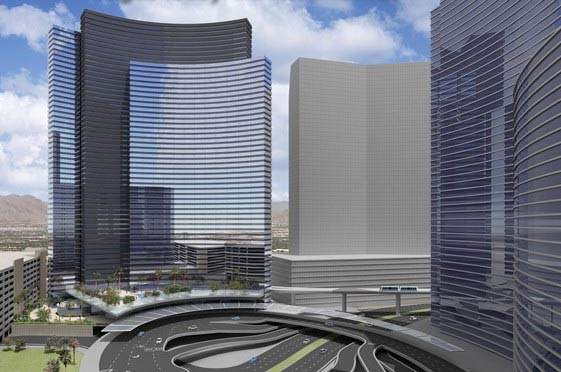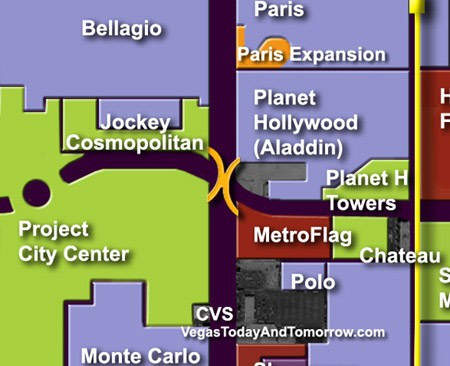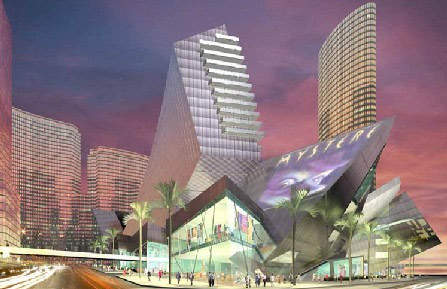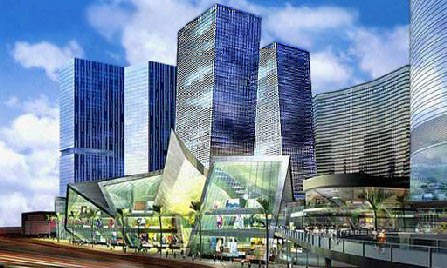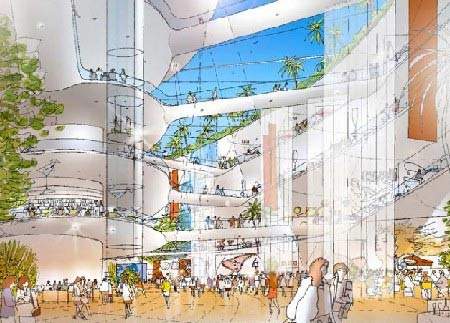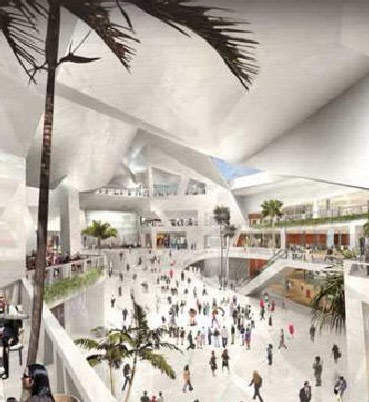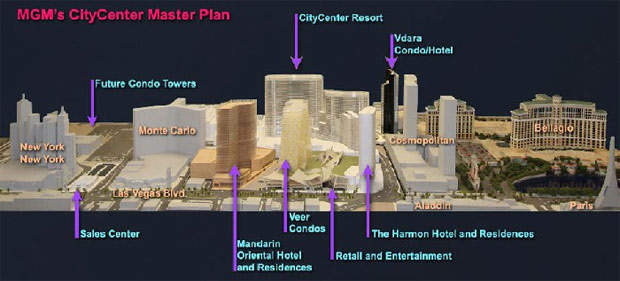The CityCenter resort project is a 76 acre, mixed-use development project constructed by MGM Mirage on the Las Vegas Strip, in Las Vegas, Nevada, US. Construction of the project began in 2006 and was completed in 2010.
The development is on the site of the demolished Boardwalk Hotel and Casino (demolished in May 2006), which is the land between the Bellagio and the Monte Carlo. The new resort is connected to the Bellagio and the Monte Carlo using a state-of-the-art people mover system.
The total cost of the CityCenter Resort project was estimated to be $11bn – the original cost estimate was $4bn, but rising prices and design changes pushed the estimate up. The project is one of the largest privately financed developments undertaken in the US. The development is not a themed resort, but includes multiple high-rise buildings with contemporary urban design.
The complex is intended to feel like an authentic city centre, with supermarkets and pavements. It is a real urban district of variety and complexity that borrows its style from traditional cities. Over 500 of the condominiums are incorporated into the retail district as lofts, brownstones and other attached-housing styles.
The CityCenter Resort forms a city within a city and MGM Mirage incorporated the two resorts it owns either side of the new project to form an integrated super resort in the heart of Las Vegas. The resort contains three of the largest casinos and a total of nearly 14,000 hotel rooms between all the hotels. CityCenter has a 0.25 mile Strip frontage.
The first phase of the project opened in December 2009, and the entire resort complex, including Harmon Hotel and Veer Towers, was completed in 2010.
CityCenter Resort development plans
The development plans for the CityCenter Resort included a 4,000-room, 60-storey CityCenter Resort tower designed by Cesar Pelli. The casino has a floor space of 165,000ft² and is designed by Cesar Pelli.
The resort has several smaller hotels and condominium residences, such as the 400-hotel room (along with 200 condominiums) Mandarin Oriental Hotel and Residences designed by Kohn, Pedersen, Fox and Tihany Design, the 400-room The Harmon Hotel / Residences designed by Foster and Partners, the 1,500-unit Vdara Condo-Hotel tower designed by Rafael Viñoly, and the twin leaning towers in the middle of the resort (350-unit Veer luxury condo towers) designed by Helmut Jahn.
In addition there is 500,000ft² of retail and entertainment space designed by Daniel Libeskind, 225,000ft² of convention and meeting space, 900,000ft² for back-of-house operations, a 2,000-seat theatre, a 70,000ft² spa, a 7,500 car parking garage, the resort’s own fire station, a people mover transportation system and an on-site central power plant.
The latter is designed and constructed by Siemens to heat, light and cool the resort, and is worth $100m.
The CityCenter retail district was planned by Taubman Centers of Michigan. The Light Design, a designer of night clubs and restaurants, was involved in the project.
Mandarin Oriental
The Mandarin Oriental Hotel Group announced in June 2005 that it would be the first to commit to a boutique hotel project within MGM’s CityCenter project. The hotel opened on 5 December 2009 and MGM planned to have two other boutique hotels on the property.
Mandarin Oriental, Las Vegas was built in a multi-towered, 37-storey building with an entrance on Las Vegas Boulevard. The building features an innovative glass façade, allowing dynamic views from public spaces as well as the hotel’s 310 spacious guestrooms and 90 luxuriously appointed suites.
The Sky Lobby, located on the hotel’s tenth floor, features a wall of windows revealing the dramatic panorama of Las Vegas and beyond to visitors and guests. There are seven dining and cocktail venues, including two signature restaurants, a lobby lounge, bar, Mandarin Cake Shop and spa cafe.
The 32,000ft² spa provides the most comprehensive range of wellness, beauty and massage treatments available in Las Vegas. The meeting and function space at Mandarin Oriental, Las Vegas is spread over 40,000ft². For the business traveller the hotel offers executive suites and a full-service business centre.
Environmentally friendly
The CityCenter Resort project design incorporated green technologies to make it one of the largest environmentally sustainable urban communities in the world. Plans included garden roofs, the use of reclaimed water and an on-site power generation plant.
MGM Mirage achieved LEED certification for the project as outlined by the US Green Building Council.
Contractors
HKS Architects was the architect-of-record and Gensler was another major project architect. Gensler was teamed with MGM Mirage’s Design Group, coordinating and collaborating with residential developers, hotel operators, and retailers and all of the contracted architects involved in aspects of the project.
The 20 month design process was completed in June 2006, with final renderings of the project released in September 2006. Butchie, Bailey and Rocky Melchiorri was the project management company. The Perini Building Company was the lead contractor with Tishman Construction Corporation, which served as the executive construction manager.
Employee parking garage and sales centre
The majority of the property on which Project CityCenter (PCC) is situated was at once the Dunes golf course. MGM was using this as an employee parking lot for its Bellagio employees. In order to clear away the cars, a new parking garage was constructed in the back of the PCC land (near I-15 and close to the Bellagio). The ten-storey, 5,300-space parking garage was completed for MGM Mirage employees in early 2006, freeing up the area for construction.
A two-storey temporary management office was constructed on an unused plot of land behind the New York–New York Hotel to house the executive project management, including staff of the executive architect, Gensler, and the executive construction manager Tishman Construction Corporation.
Phases of construction
CityCenter was constructed in three phases: A, B and C. As of November 2006 the main hotel was built up to level 5. The foundation for the Mandarin Oriental was poured in November 2006.
The Panorama Towers topped out as of January 2007 and work began on the foundations and underground parking garage of the Cosmopolitan (retail area). The combined project totals approximately 16,797,000ft² of floor space, 7,190 hotel rooms and resort and hotel condominium units.
Phase A
Phase A of the project consisted of 10,345,000ft² of floor space. This included the main resort hotel with a 155,000ft² casino area, a three storey, 565,000ft² convention centre and a 2,000-seat theatre.
Back-of-house areas, offices, two parking garages, one of which was a 13-level parking structure and an underground garage located beneath the casino, were also built.
Phase B
Phase B of the project consisted of 1,460,000ft² of floor space and included a total of 2,860 hotel and resort condominium units within two high-rise towers and various open space and recreational areas.
The resort condominium tower is 585ft high with 120 units, and the hotel condominium tower is 585ft high with 1,050 units.
A shopping centre area consisting of 17,000ft² is incorporated into the tower buildings. Parking for this area is provided within the Bellagio employee garage, which has already been finished.
Phase C
Phase C of the project consisted of 4,992,000ft² of floor space including two high-rise hotel towers, 596,000ft² of shopping areas and associated offices and support areas. This area is dominated by two 548ft hotel towers consisting of 400 rooms each. The Mandarin Oriental Hotel is at the south end and the Lifestyle Hotel is on the north end at the junction of Las Vegas Boulevard South and Harmon Avenue.
A total of 1,620 resort condo units were built within the block, distributed within each hotel tower and mid-rise buildings above the Sobella shopping centre. Parking for this area is provided by an eight-level parking structure located just south of the Mandarin Oriental Hotel and a one-level subterranean parking structure underneath the new shopping centre.
Investment in the City Center Resort
In April 2009, MGM Mirage received bank support to fund 100% of the construction costs for Citycenter, to the tune of $70m. CityCenter is a joint venture between MGM MIRAGE and Infinity World Development, a subsidiary of Dubai World.


